Conjugatal extrusion with dextral deformation in the Southeast Tibet: New insight into the Oligo-Miocene deformation in the Southeast Tibet
IF 2.6
3区 地球科学
Q2 GEOSCIENCES, MULTIDISCIPLINARY
引用次数: 0
Abstract
The Southeast Tibet has experienced significant deformation during the Late Cenozoic period, characterized by clockwise block rotation and separated by left-lateral strike-slip faults. Through our new field survey, structural analyses and microstructural observations, we have identified an early phase of ductile shear zones along three major faults: the Anninghe, Jinhe-Jinghe fault and Jinpingshan faults. New geochronological and thermochronological data collected from fault zones and carbonatites associated with a tear fault between two right-lateral oblique faults provides evidences that the slip occurred before ∼30 Ma. These new findings have led to a new conceptual model suggests that these NS-trending right-lateral oblique-slip faults, together with these NW-trending left-lateral strike-slip faults in Southeast Tibet, form a network of large conjugate fractures. The network was formed due to N-NE-trending contraction and played a crucial role in controlling the overall tectonic frame of Southeast Tibet during the Oligocene. By compiling and reviewing previous research with our latest findings, we propose that the region has undergone a transtion from oblique dextral to sinistral shearing since the Oligocene, providing new insights into the tectonic evolution of the East Tibet. Thematic collection: This article is part of the Mesozoic and Cenozoic tectonics, landscape and climate change collection available at: https://www.lyellcollection.org/topic/collections/mesozoic-and-cenozoic-tectonics-landscape-and-climate-change Supplementary material: https://doi.org/10.6084/m9.figshare.c.7262890藏东南共生挤压与右旋变形:藏东南中新世变形的新认识
藏东南地区在晚新生代时期经历了显著的变形,其特征是顺时针块体旋转和左侧走向滑动断层的分隔。通过新的野外调查、构造分析和微结构观察,我们确定了安宁河断层、金河-金河断层和锦屏山断层这三大断层沿线的韧性剪切带的早期阶段。从与两个右侧斜断层之间的撕裂断层相关的断层带和碳酸盐岩中收集的新的地质年代和热年代学数据,提供了滑动发生在30 Ma之前的证据。这些新发现提出了一个新的概念模型,即这些NS向的右侧斜向滑动断层与藏东南这些NW向的左侧走向滑动断层共同形成了一个大型共轭断裂网络。该断裂网的形成是由于N-NE向的收缩作用,对控制渐新世时期藏东南地区的整体构造框架起到了至关重要的作用。通过对前人研究和最新发现的梳理和回顾,我们提出该地区自渐新世以来经历了从斜向右旋剪切到正弦剪切的转变,为藏东地区的构造演化提供了新的认识。 专题文集:本文是中生代和新生代构造、地貌和气候变化文集的一部分,可在以下网址查阅: https://www.lyellcollection.org/topic/collections/mesozoic-and-cenozoic-tectonics-landscape-and-climate-change 补充材料: https://doi.org/10.6084/m9.figshare.c.7262890
本文章由计算机程序翻译,如有差异,请以英文原文为准。
求助全文
约1分钟内获得全文
求助全文
来源期刊

Journal of the Geological Society
地学-地球科学综合
CiteScore
6.00
自引率
3.70%
发文量
68
审稿时长
6-12 weeks
期刊介绍:
Journal of the Geological Society (JGS) is owned and published by the Geological Society of London.
JGS publishes topical, high-quality recent research across the full range of Earth Sciences. Papers are interdisciplinary in nature and emphasize the development of an understanding of fundamental geological processes. Broad interest articles that refer to regional studies, but which extend beyond their geographical context are also welcomed.
Each year JGS presents the ‘JGS Early Career Award'' for papers published in the journal, which rewards the writing of well-written, exciting papers from early career geologists.
The journal publishes research and invited review articles, discussion papers and thematic sets.
 求助内容:
求助内容: 应助结果提醒方式:
应助结果提醒方式:


